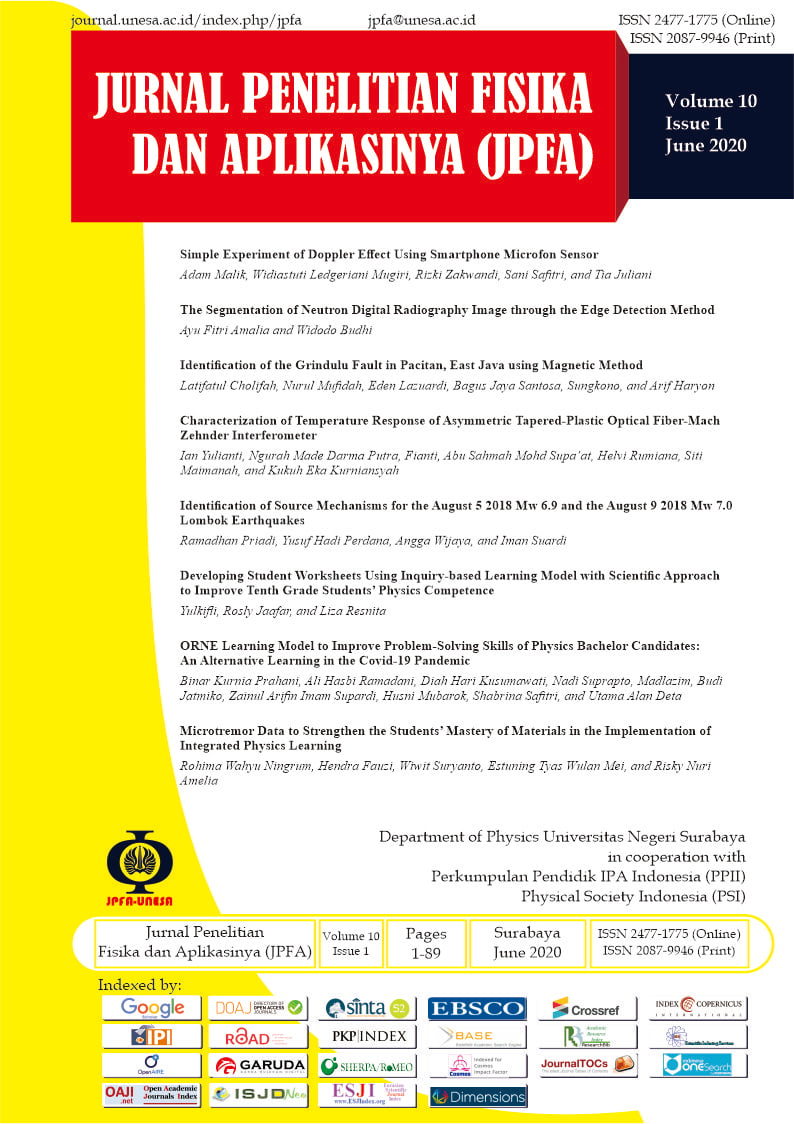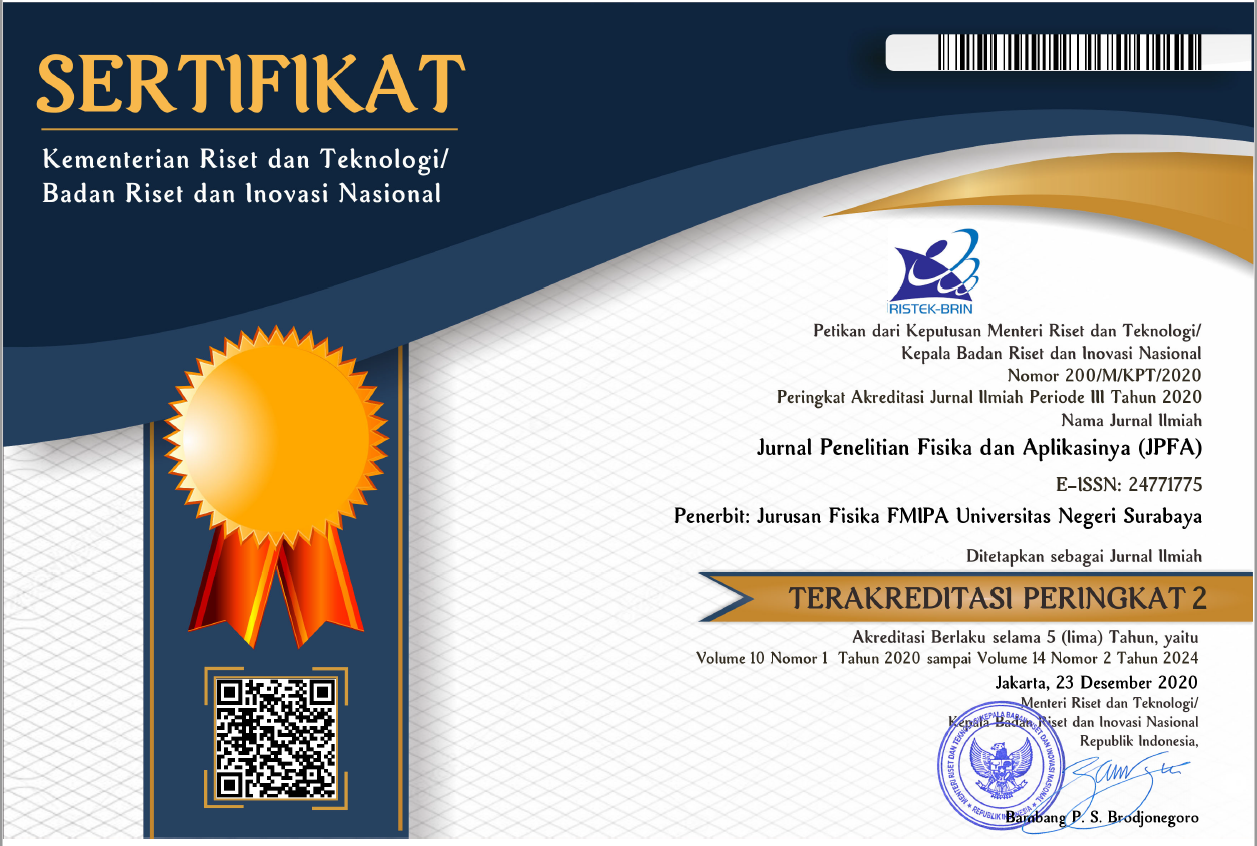Identification of the Grindulu Fault in Pacitan, East Java using Magnetic Method
DOI:
https://doi.org/10.26740/jpfa.v10n1.p22-33Keywords:
Grindulu Fault, Pacitan, magnetic methodAbstract
Magnetic method in geophysical surveys is common for its non-destructive use of sub-surface structure delineation. In this study, ground-based measurements of magnetic intensity were performed using a set of instruments in some regions of Pacitan, a city in the southern area of East Java province. Based on these measurements, data acquisition was used to identify the Grindulu faulting zone in the region of interest, potentially vulnerable to geohazards. The data were first corrected using the IGRF and diurnal corrections. A filtering technique of upward continuation at a height of 900 m was then applied to separate local anomalies from regional ones as the targeted sources in the present case. These separate anomalies and their corresponding reductions to the poles as further filtering processes were analyzed for predicting the location and direction of the fault. The results, extracted from data analysis and interpretation, show that the main path of the Grindulu is directed along the NE-SW fault line or N60oE. The resulting anomalies also reflect that the Grindulu is a normal fault with surrounding minor faults lying across the Grindulu, calling for increased awareness of vulnerability in the city to seismic threats.References
Anchuela OP, Lafuente P, Arlegui L, Liesa CL, and Simón JL. Geophysical Characterization of Buried Active Faults: The Concud Fault (Iberian Chain, NE Spain). International Journal of Earth Sciences. 2016; 105: 2221-2239. DOI: https://doi.org/10.1007/s00531-015-1283-y.
Syukri M, Marwan, Safitri R, Fadli Z, Andika F, and Saad R. Ground Magnetic Survey Used to Identify The Weathered Zone, in Blang Bintang, Aceh, Indonesia. IOP Conference Series: Earth and Environmental Science. 2017; 56: 012017. DOI: https://dx.doi.org/10.1088/1755-1315/56/1/012017.
Saheel AS, Bin Samsudin AR, and Bin Hamzah U. Mapping of Faults in The Libyan Sirte Basin by Magnetic Surveys. Sains Malaysiana. 2011; 40(8): 853-864. Available from: http://www.ukm.my/jsm/pdf_files/SM-PDF-40-8-2011/06%20Umar.pdf.
Araffa SAS, Santos FAM, and Arefa-Hamid T. Delineating Active Faults by Using Integrated Geophysical Data at Northeastern Part of Cairo, Egypt. NRIAG Journal of Astronomy and Geophysics. 2012; 1(1): 33-44. DOI: https://doi.org/10.1016/j.nrjag.2012.11.004.
Pereira AND. Geophysical Fault Mapping Using The Magnetic Method at Hickory Sandstone Aquifer, Ilano Uplift, Texas. Dissertation. Unpublished. Texas: Texas A & M University; 2013.
Supendi P, Nugraha AD, Puspito NT, Widiyantoro S, and Daryono D.. Identification of Active Faults in West Java, Indonesia, Based on Earthquake Hypocenter Determination, Relocation, and Focal Mechanism Analysis. Geoscience Letters. 2018; 5: 31. DOI: https://doi.org/10.1186/s40562-018-0130-y.
Koulali A, Susilo S, McClusky S, Meilano I, Cummins P, Tregoning P, Lister G, Efendi J, and SyafiI MA. Crustal Strain Partitioning and The Associated Earthquake Hazard In The Eastern Sunda-Banda Arc. Geophysical Research Letters. 2016; 43(5): 1943-1949. DOI: http://dx.doi.org/10.1002/2016GL067941.
Pusat Sudi Gempa Nasional. Peta Sumber dan Bahaya Gempa Indonesia Tahun 2017. Bandung: Pusat Litbang Perumahan dan Permukiman, Kementerian Pekerjaan Umum dan Perumahan Rakyat; 2017.
Cummins PR. Geohazards in Indonesia: Earth Science for Disaster Risk Reduction Introduction. Geological Society of London: Special Publications. 2017; 441(1): 1-7. DOI: https://doi.org/10.1144/SP441.11.
Sungkono dan Santosa BJ. Laporan Akhir Program Penelitian Laboratorium Dana Lokal ITS Tahun Anggaran 2019. Research Report. Unpublished. Surabaya: Institut Teknologi Sepuluh Nopember; 2019.
Susilo A and Adnan Z. Probabilistic Seismic Hazard Analysis of East Java region, Indonesia. International Journal of Computer and Electrical Engineering. 2013; 5(3): 341-344. DOI: https://doi.org/10.7763/IJCEE.2013.V5.728
Smyth HR, Hall R, and Nicholls GJ. Cenozoic Volcanic Arc History of East Java, Indonesia: The Stratigraphic Record of Eruptions on an Active Continental Margin. The Geological Society of America Special Paper. 2008; 436: 199-222. DOI: https://doi.org/10.1130/2008.2436(10).
Hall R. Late Jurassic Cenozoic Reconstruction of the Indonesian Region and the Indian Ocean. Tectonophysics. 2012; 570-571: 1-41. DOI: https://doi.org/10.1016/j.tecto.2012.04.021.
Lei Y, Jiao L, and Chen H. Possible Correlation Between The Vertical Component of Lithospheric Magnetic Field and Continental Seismicity. Earth, Planets and Space. 2018: 70(179); 1-19. DOI: https://doi.org/10.1186/s40623-018-0949-7.
Araffa SAS, El-Bohoty M, Heleika AM, Mekkawi M, Ismail E, Khalil A, and El-Razek EMA. Implementation Of Magnetic and Gravity Methods to Delineate The Subsurface Structural Features of The Basement Complex in Central Sinai Area, Egypt. NRIAG Journal of Astronomy and Geophysics. 2018; 7(1): 162-174. DOI: https://doi.org/10.1016/j.nrjag.2017.12.002.
Panovska S, Korte M, and Constable CG. One Hundred Thousand Years of Geomagnetic Evolution. Review of Geophysics. 2019; 57(4): 1-49. DOI: http://doi.org/10.1029/2019RG000656.
Wicht J and Sanchez S. Advances in Geodynamo Modeling. Geophysical and Astrophysical Fluid Dynamics. 2019; 113(1-2): 2-50. DOI: https://doi.org/10.1080/03091929.2019.1597074.
Bukhari SY. Magnetic Susceptibilities and Fault Surface Anomalies. The Study of Land Magnetic Data & Interpretations. International Journal of Recent Technology and Engineering. 2019; 7(6): 1053-1056. Available from: https://www.ijrte.org/wp-content/uploads/papers/v7i6/F2654037619.pdf.
Hinze WJ, Von Frese RRB, and Saad AH. Gravity and Magnetic Explorations: principles, practices, and applications. Cambridge: Cambridge University Press; 2013.
Samodra H, Gafoer S, dan Tjokrosapoetro S. Peta Geologi Lembar Pacitan, Jawa. Pusat Penelitian dan Pengembangan Geologi. 1992. Available from: https://opac.perpusnas.go.id/DetailOpac.aspx?id=369362.
Al-Hakim AY and Sulistijo B. Integrated Exploration Method to Determine Cu Prospect in Seweden District, Blitar, East Java. Procedia Earth and Planetary Science. 2013; 6: 64-69. Available from: https://core.ac.uk/download/pdf/82350337.pdf .
Alken P, Maus S, Chulliat A, Manoj C. NOAA/NGDC Candidate Models for the 12th Generation International Geomagnetic Reference Field. Earth, Planets and Space. 2015; 67(68): 1-9. DOI: https://doi.org/10.1186/s40623-015-0215-1.
Thébault E, Finlay CC, Beggan CD, Alken P, Aubert J, Barrois O, Bertrand F, Bondar T, Boness A, Brocco L, Canet E, Chambodut A, Chulliat A, Coïsson P, Civet F, Du1 A, Fournier A, Fratter I, Gillet N, Hamilton B, Hamoudi M, Hulot G, Jager T, Korte M, Kuang W, Lalanne X, Langlais B, Léger JM, Lesur V, Lowes FJ, Macmillan S, Mandea M, Manoj Ch, Maus S, Olsen N, Petrov V, Ridley V, Rother M, Sabaka TJ, Saturnino D, Schachtschneider R, Siro O, Tangborn A, Thomson A, Tøffner-Clausen L, Vigneron P, Wardinski I, and Zvereva T. International Geomagnetic Reference Field: the 12th Generation. Earth, Planets, and Space. 2015: 67(79); 1-19. DOI: https://doi.org/10.1186/s40623-015-0228-9.
Ravat D. Upward and Downward Continuation. In: Gubbins D, and Herrero-Bervera E (Eds). Encyclopedia of Geomagnetism and Paleomagnetism. Switzerland: Springer; 2007: 974-976. DOI: https://doi.org/10.1007/978-1-4020-4423-6_311.
Ravat D. Reduction to Pole. In: Gubbins D, and Herrero-Bervera E (Eds). Encyclopedia of Geomagnetism and Paleomagnetism. Switzerland: Springer; 2007: 856-857. DOI: https://dx.doi.org/10.1007/978-1-4020-4423-6_275.
Oehler JF, Rouxel D, and Lequentrec-Lalancette MF. Comparison of Global Geomagnetic Field Models and Evaluation Using Marine Datasets in The North-Eastern Atlantic Ocean and Western Mediterranean Sea. Earth, Planets, and Space. 2018; 70(99): 1-15. DOI: https://doi.org/10.1186/s40623-018-0872-y.
Yamazaki Y and Maute A. Sq and EEJ”A Review on The Daily Variation of The Geomagnetic Field Caused by Ionospheric Dynamo Currents. Space Science Reviews. 2017; 206: 299-405. DOI: https://doi.org/10.1007/s11214-016-0282-z.
Everett ME. Near-Surface Applied Geophysics. Cambridge: Cambridge University Press; 2013. DOI: https://doi.org/10.1017/CBO9781139088435.
Borovsky JE and Shprits YY. Is the Dst Index Sufficient to Define All Geospace Storms? Journal of Geophysical Research: Space Physics. 2018; 122(11): 11543-11547. DOI: https://doi.org/10.1002/2017JA024679.
Pilkington M and Boulanger O. Potential Field Continuation Between Arbitrary Surfaces - Comparing Methods. Geophysics. 2017; 82(3): 9-25. DOI: https://doi.org/10.1190/GEO2016-0210.1.
Ilapadila, Harimei B, and Maria. Analysis of Regional Anomaly on Magnetic Data Using the Upward Continuation Method. IOP Conference Series: Earth and Environmental Science. 2019; 279: 012037. DOI: https://dx.doi.org/10.1088/1755-1315/279/1/012037.
Laundal KM and Richmond AD. Magnetic Coordinate Systems. Space Science Reviews. 2017; 206: 27-59. DOI: https://doi.org/10.1007/s11214-016-0275-y.
Amoah BK, Dadzie I, and Takyi-Keremeh K. Integrating Gravity and Magnetic Field Data to Delineate Structurally Controlled Gold Mineralization in the Sefwi Belt of Ghana. Journal of Geophysics and Engineering. 2018; 15(4): 1197-12303. DOI: https://doi.org/10.1088/1742-2140/aaa7b2.
Karasozën E, Nissen E, Bergman EA, Johnson KL, and Walters EJ. Normal Faulting in The Simav Graben of Western Turkey Reassessed with Calibrated Earthquake Relocations. Journal of Geophysical Research: Solid Earth. 2016; 121(6): 4553-4574. DOI: https://doi.org/10.1002/2016JB012828.
Ibraheem IM, Haggag M and Tezkan B. Edge Detectors as Structural Imaging Tools Using Aeromagnetic Data: A Case Study of Sohag Area, Egypt. Geosciences. 2019; 9(5): 1-13. DOI: https://doi.org/10.3390/geosciences9050211.
Susilo A, Sunaryo, Fitriah F, and Sarjiyana. Fault Analysis in Pohgajih Village, Blitar, Indonesia Using Resistivity Method for Hazard Risk Reduction. International Journal of GEOMATE. 2018; 14(41): 111-118. DOI: https://doi.org/10.21660/2018.41.87552.
Nisa AK, Irawan MI, and Pratomo DG. Identification of Potential Landslide Disaster in East Java Using Neural Network Model (Case Study: District of Ponogoro). Journal of Physics: Conference Series. 2019; 1366: 012095. DOI: https://dx.doi.org/10.1088/1742-6596/1366/1/012095.
Downloads
Published
How to Cite
Issue
Section
License
Author(s) who wish to publish with this journal should agree to the following terms:
- Author(s) retain copyright and grant the journal right of first publication with the work simultaneously licensed under a Creative Commons Attribution-Non Commercial 4.0 License (CC BY-NC) that allows others to share the work with an acknowledgement of the work's authorship and initial publication in this journal for noncommercial purposes.
- Author(s) are able to enter into separate, additional contractual arrangements for the non-exclusive distribution of the journal's published version of the work (e.g., post it to an institutional repository or publish it in a book), with an acknowledgement of its initial publication in this journal.
The publisher publish and distribute the Article with the copyright notice to the JPFA with the article license CC-BY-NC 4.0.
 Abstract views: 1282
,
Abstract views: 1282
, PDF Downloads: 985
PDF Downloads: 985









